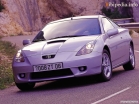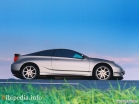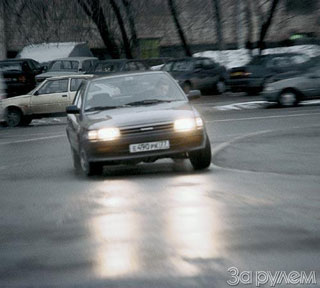Toyota Celica 1999 test drive - 2002 compartment
Long -lived
 Our Cariniad is coming to an end - of the three Toyota Karina II cars in the editorial office of Toyota II cars, and that soon we will sell it soon. The purpose of the experiment is to compare the operational expenses of the new domestic and equal at the price of a used foreign car - achieved, it is time to update the park, because today Karina is already half the less cheaper than the new VAZ 21103.
Our Cariniad is coming to an end - of the three Toyota Karina II cars in the editorial office of Toyota II cars, and that soon we will sell it soon. The purpose of the experiment is to compare the operational expenses of the new domestic and equal at the price of a used foreign car - achieved, it is time to update the park, because today Karina is already half the less cheaper than the new VAZ 21103. So, four years ago, having sipped a dashing with a used Volkswagen passage (it was a whole epic - with customs clearance, inspections and a chronic refusal of the brake amplifier), they decided to buy a car, as they say, without problems. Having vast sources of information from owners and specialists from all over Russia and from abroad, we agreed that Japanese cars deserve to the greatest extent, and Toyota among them.
 The eight -year -old Karina color was bought by wet asphalt at a road, even a pre -crisis price - $ 7600 and this time they chose a car with Moscow numbers and TCP. As it turned out, the power of Japanese women is not only in durability - to feel the difference with the German (by the way, the same age and classmate), it was enough to drive the first ten meters or even just open and close the door. Despite the fact that Toyota lived in raw Holland, the condition of the body was excellent, and the motor, which worked about 150 thousand km, was quite fresh. In general, given the then high cost of used foreign cars (the new VAZ 21093 in 1997 cost the same $ 7600), they believed that we were lucky with the purchase.
The eight -year -old Karina color was bought by wet asphalt at a road, even a pre -crisis price - $ 7600 and this time they chose a car with Moscow numbers and TCP. As it turned out, the power of Japanese women is not only in durability - to feel the difference with the German (by the way, the same age and classmate), it was enough to drive the first ten meters or even just open and close the door. Despite the fact that Toyota lived in raw Holland, the condition of the body was excellent, and the motor, which worked about 150 thousand km, was quite fresh. In general, given the then high cost of used foreign cars (the new VAZ 21093 in 1997 cost the same $ 7600), they believed that we were lucky with the purchase. After everyone in turn rolled and exchanged delights, workdays began for Karina. Over the next four years, she ran 100 thousand km, refuting the common opinion that the inevitable replacement of the resource that has developed the resource allegedly with a heavy burden falls on the owners of a foreign second-house ... In fact, the costs of spare parts amounted to only $ 608 (see Table 1) . Yes, this is much more expensive than a similar set of parts for VAZ 21093, but compared to fuel costs, insignificantly. Even if we always went on gasoline (recall: on the first Toyota there were a gas -tank equipment), the dollars spent on spare parts would be repaired by saving fuel, about 1.5 l/100 km compared to the carburetor nine. By the way, we sold Karin for the same $ 2000, which can now really be obtained for VAZ 21093 1997.
 So, the account is equal? Really, taking into account $ 2800 for gas and oil, four years shaking on the Vazovskaya rattle would cost the same $ 8,000 (that is, $ 0.08 per kilometer), as well as enjoyment of a foreign car? Uh, no - less optimism! And who will count the clutch discs, thermostats, sensors, relay, crows, etc., which would be required for nine for this run? And how much would regular visits for the service cost? And the liters of the antifreeze spilled onto the road when the fan failure? And in general, 100 thousand km - sometimes, too much for the modern nine motor. Without overhaul ($ 200), most likely, you could not do ... Yes, and the box would have to be sorted out once or twice, and to repaint the car for sale is a common thing, otherwise who will buy it? .. In short, we will throw a couple more thousand thousand dollars: About the same to us saved Toyota - the car without problems.
So, the account is equal? Really, taking into account $ 2800 for gas and oil, four years shaking on the Vazovskaya rattle would cost the same $ 8,000 (that is, $ 0.08 per kilometer), as well as enjoyment of a foreign car? Uh, no - less optimism! And who will count the clutch discs, thermostats, sensors, relay, crows, etc., which would be required for nine for this run? And how much would regular visits for the service cost? And the liters of the antifreeze spilled onto the road when the fan failure? And in general, 100 thousand km - sometimes, too much for the modern nine motor. Without overhaul ($ 200), most likely, you could not do ... Yes, and the box would have to be sorted out once or twice, and to repaint the car for sale is a common thing, otherwise who will buy it? .. In short, we will throw a couple more thousand thousand dollars: About the same to us saved Toyota - the car without problems. Beige metallic was bought a second carina of color, of course, under the influence of the first, but in a hurry, which was later regretted. No, the car itself was almost in perfect condition, it was just that it was immediately after the default, when the sellers on the inertia continued to break prices. Well, seven thousand - this, of course, is too much, and 4,500 counted acceptable - it was painfully good Karina in the suite brought from Germany.
It so happened that in two years of work in the editorial office she went only 12 thousand km, so the final losses were quite large when selling in November 2000. Having folded $ 4500 with gas and oil costs - $ 300 and adding another 300 to spare parts (see table. 2), and then deducted $ 2600 paid to us by the new buyer, we get $ 2500. Thus, the silence, comfort and reliability of a used Japanese man cost about $ 0.2 per kilometer. This is clearly more than a new nine or a dozen would eat, although half as much as a new foreign car of the same class. (For example, Nissan Maxim Transzhyril for $ 0.4/km - see ZR, 2000, No. 10.) Eh, we will take place with the purchase of a second Toyota for four months, it would cost a third cheaper, and a kilometer would cost ten cents ...
The third sister in the Karin family was acquired after a thorough study of the market. Initially, instead of it, they planned similar to the units and equally reliable, but more compact Corolla. However, the situation in the market forced to abandon the C-class popular in Europe-the owners of such machines, as a rule, are not rich and jail, so they put up their cars for sale like some kind of treasure, trying to return almost the entire amount invested in it. And larger vectors, passats, carines and chords are bought by fairly wealthy people, changing cars often and, of course, for new ones - hence the excess D -class in the secondary market and reasonable prices. In Russia, by the way, the same thing. Slightly rich yesterday's Lada, having bought the first foreign car in their lives (Dau Nexia, Skoda Felicia, Hyunde accent, etc.), subsequently hold a circular defense in the market, voluntarily giving potential buyers to more flexible owners of large and luxurious clarus, condori, sonata.
So we, leaving the sellers of the five thousandth Korolls and continue to wander above our gold, looked at the silver brown with the body of the liftback. Understanding that there are few such cars in advertising newspapers than buyers, the owner politely moved to $ 3,000. The examination showed that he did not have time to break anything serious, and before him, in Germany, the car was apparently served as expected.
 By putting the car in order for $ 300 (windshield, pads, cables), since then we buy only consumables. The car was converted for inexpensive fuel filters (they are ready to tell you more about this). Oil - that Fram, that the champion - cost $ 6, and do not disappear from the shelves, but the air is a deficit. They found the original $ 16 - of course, not on the service, but from a small dealer buying Japanese spare parts in Arab emirates, where they are half cheaper.
By putting the car in order for $ 300 (windshield, pads, cables), since then we buy only consumables. The car was converted for inexpensive fuel filters (they are ready to tell you more about this). Oil - that Fram, that the champion - cost $ 6, and do not disappear from the shelves, but the air is a deficit. They found the original $ 16 - of course, not on the service, but from a small dealer buying Japanese spare parts in Arab emirates, where they are half cheaper. For the first time, the Candso Q16R -U candy CAR -U first appeared on sale for the first time - they immediately put it, although they worked out less than 10 thousand km. En-Ji Kay (NGK) also proved to be excellent. One hundred percent transmission synthetics of the liquor ground, filled into a gearbox immediately after buying a car, will probably replace only the future host - the loss of zero, the crankcase is completely dry outside. But the engine oil has already been changed twice - since the part of the editorial park has been transferred to the asterian synthetics of the company Motul, the remaining Karina also travels on a 300V viscosity of 15W50. So that the nozzles are not clogged with resins, we pour gasoline AI-95 only on proven columns. Nevertheless, on the eve of winter, the system was prophylactically washed at the service (Read more about this procedure in ZR, 2000, No. 6, p. 136). As soon as the firm of Vince, circulating in the fuel ramp, drove the resinous deposits through the nozzles, the motor, which had previously worked perfectly evenly, suddenly shook and at times even stalls, forcing him to let him in again and again. Only twenty minutes later, when he calmed down and froze, quietly rustling with pistons, it became clear that all the dirt accumulated in the system settled in the filter of a flushing installation or burned in the cylinders.
To summarize the economic result of the operation of the third Karina after 14 thousand km. It’s too early - here we will sell, then we will calculate. But now it is clear that the silver went to the record - as cheap as on it, you can ride, perhaps, only on the Oka, and then not for long. But most importantly, this Toyota, released 12 years ago, is a dumb reproach for the Russian automobile industry. Every year, without preparation and bribes, passing instrumental control (CO - 0.18%), roomy as a Volga, a Japanese old woman develops 185 km/h, burning an average of about 6 liters of gasoline per 100 kilometers ...
Rinse the nozzles is better on the service.
Text / Anton Utkin
Source: The magazine "Driving"






